
Concept explainers
(a)
Interpretation:
The resonance structures with an octet about the central atom and a resonance structure that has minimum formal charges for the following structure has to be determined.
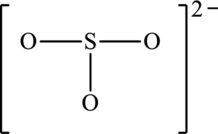
Concept Introduction:
A covalent bond is a bond that is formed from the mutual sharing of electrons between atoms. Lewis structures are representations of the covalent bond. In this, Lewis symbols show how the valence electrons are present in the molecule.
Steps to write Lewis structures are as follows:
1. The skeleton structure with single bonds between all bonded atoms has to be written
2. Sum the valence electrons of the atoms in the molecule.
(a) For cations, one electron is subtracted for each positive charge.
(b) For anions, one electron is added for each negative charge.
3. Subtract two electrons from total number of valence electrons for each bond in the skeleton structure.
4. Count the number of electrons required to satisfy the octet rule for each atom in the structure. If the number of electrons needed is less than the number remaining, add one bond for every two electrons needed between atoms to attain an octet.
5. The remaining electrons are placed as lone pairs on atoms that need them to satisfy the octet rule.
The formula to calculate formal charge of atom is,
Some molecules do not have only one Lewis structure. The Lewis structures that differ only in the arrangement of multiple bonds are called resonance structures.
Resonance structure comprises of two or more Lewis Structures that describes the arrangement of bond of a single species and include fractional bonds and fractional charges.
(a)
Answer to Problem 9.82QE
The resonance structure that has an octet around central atom is as follows:

The resonance structure that minimizes formal charge is as follows:

Explanation of Solution
The skeleton structure is as follows:

The resonance structures are as follows:
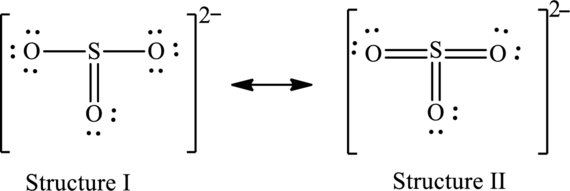
For structure I:
Substitute 6 for valence electrons, 0 for number of lone pairs of electrons and 8 for the number of shared electrons in equation (1) to calculate the formal charge on
Substitute 6 for valence electrons, 6 for number of lone pairs of electrons and 2 for the number of shared electrons in equation (1) to calculate the formal charge on first oxygen atom.
Substitute 6 for valence electrons, 4 for number of lone pairs of electrons and 4 for the number of shared electrons in equation (1) to calculate the formal charge on second oxygen atom.
Substitute 6 for valence electrons, 6 for number of lone pairs of electrons and 2 for the number of shared electrons in equation (1) to calculate the formal charge on third oxygen atom.
For structure II:
Substitute 6 for valence electrons, 0 for the number of lone pairs of electrons and 12 for the number of shared electrons in equation (1) to calculate the formal charge on
Substitute 6 for valence electrons, 4 for number of lone pairs of electrons and 4 for the number of shared electrons in equation (1) to calculate the formal charge on first oxygen atom.
Substitute 6 for valence electrons, 4 for number of lone pairs of electrons and 4 for the number of shared electrons in equation (1) to calculate the formal charge on second oxygen atom.
Substitute 6 for valence electrons, 4 for number of lone pairs of electrons and 4 for the number of shared electrons in equation (1) to calculate the formal charge on third oxygen atom.
Possible resonance structures are as follows:
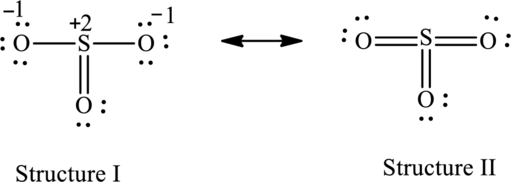
Hence, structure I has an octet around central atom and structure II minimizes the formal charge.
(b)
Interpretation:
The resonance structures with an octet about the central atom and a resonance structure that has minimum formal charges for the following structure has to be determined.

Concept introduction:
Refer to part (a)
(b)
Answer to Problem 9.82QE
The resonance structure that has an octet around central atom is as follows:

The resonance structure that minimizes formal charge is as follows:
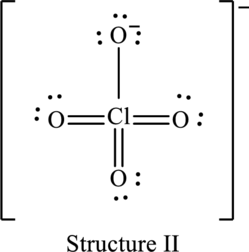
Explanation of Solution
The skeleton structure is as follows:

The possible resonance structures are as follows:
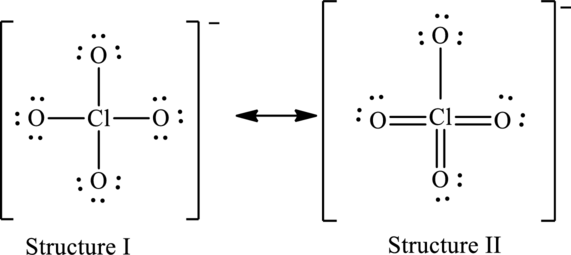
For structure I:
Substitute 7 for valence electrons, 4 for the number of lone pairs of electrons and 4 for the number of shared electrons in equation (1) to calculate the formal charge on
Substitute 6 for valence electrons, 6 for number of lone pairs of electrons and 2 for the number of shared electrons in equation (1) to calculate the formal charge on first oxygen atom.
Substitute 6 for valence electrons, 6 for number of lone pairs of electrons and 2 for the number of shared electrons in equation (1) to calculate the formal charge on second oxygen atom.
Substitute 6 for valence electrons, 6 for number of lone pairs of electrons and 2 for the number of shared electrons in equation (1) to calculate the formal charge on third oxygen atom.
Substitute 6 for valence electrons, 6 for number of lone pairs of electrons and 2 for the number of shared electrons in equation (1) to calculate the formal charge on fourth oxygen atom.
For structure II:
Substitute 7 for valence electrons, 0 for the number of lone pairs of electrons and 8 for the number of shared electrons in equation (1) to calculate the formal charge on
Substitute 6 for valence electrons, 4 for number of lone pairs of electrons and 4for the number of shared electrons in equation (1) to calculate the formal charge on first oxygen atom.
Substitute 6 for valence electrons, 6 for number of lone pairs of electrons and 2 for the number of shared electrons in equation (1) to calculate the formal charge on second oxygen atom.
Substitute 6 for valence electrons, 4 for number of lone pairs of electrons and 4 for the number of shared electrons in equation (1) to calculate the formal charge on third oxygen atom.
Substitute 6 for valence electrons, 4 for number of lone pairs of electrons and 4 for the number of shared electrons in equation (1) to calculate the formal charge on fourth oxygen atom.
Possible resonance structures are as follows:
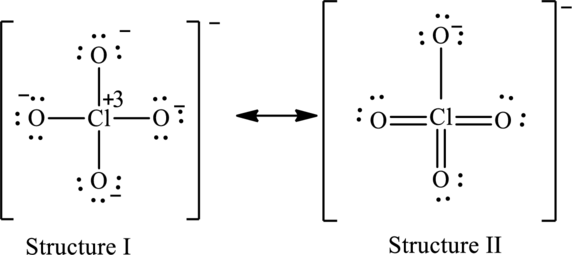
Hence, structure I has an octet around central atom and structure II minimizes the formal charge.
Want to see more full solutions like this?
Chapter 9 Solutions
Chemistry
- In the Lewis structure for cyanate ion given below, what is the formal charge on the carbon atom?arrow_forwardIn the fictitious molecule, highlight the atoms that have nonzero formal charges. Assume all lone pairs are shown.arrow_forwardDo not give handwriting solution. What is the formal charge of structure C?arrow_forward
- For resonance structures, I am confused how many arrows are necessary to produce a necessary resonance structure. The first/white picture represents an example given by the textbook (utilizing one arrow). The second picture/in pen is my own work (utilizing three arrows). Both produce a positive and negative charge. Are they both correct? Or is one supposed to use the least amount of arrows when producing resonance structures?arrow_forwardLewis structures showing all valence electrons. Assign formal charges in structure as appropriatearrow_forwardwhy is ethane a nonpolar covalent bond? I get that it is because they have "equal" shared valence electrons- but how do we know that? It seems they are on opposite sides of the periodic table, so I thought they have vastly different electronegativity.arrow_forward
- Write the resonance structure that would result from moving the electrons as the curved arrows indicate. Be sure to include formal charges if needed.arrow_forwardWhich labeled atom(s) in the following compound is (are) in violation of the octet rule?arrow_forwardAre the bond lengths or angles in benzene, comparedto other hydrocarbons, sufficient to decide if benzene exhibits resonanceand is especially stable? Discuss.arrow_forward
 Chemistry: The Molecular ScienceChemistryISBN:9781285199047Author:John W. Moore, Conrad L. StanitskiPublisher:Cengage Learning
Chemistry: The Molecular ScienceChemistryISBN:9781285199047Author:John W. Moore, Conrad L. StanitskiPublisher:Cengage Learning Introductory Chemistry: An Active Learning Approa...ChemistryISBN:9781305079250Author:Mark S. Cracolice, Ed PetersPublisher:Cengage Learning
Introductory Chemistry: An Active Learning Approa...ChemistryISBN:9781305079250Author:Mark S. Cracolice, Ed PetersPublisher:Cengage Learning


